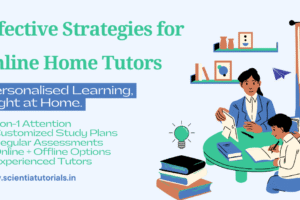Understanding Learning Styles: Tailoring Your Teaching Approach as a Home Tutor
Introduction
In the realm of education, one size does not fit all. Each student possesses a unique set of learning preferences that can significantly impact their ability to absorb and retain information. As a home tutor, understanding these learning styles is crucial for creating a tailored teaching approach that maximizes your student’s potential. This article delves into the various learning styles, the importance of adapting your teaching methods, and practical tips for implementing these strategies in your tutoring sessions.
The Importance of Learning Styles
What Are Learning Styles?
Learning styles refer to the various approaches individuals take to absorb, process, and retain information. While numerous models exist, one of the most widely recognized frameworks categorizes learning styles into four primary types: visual, auditory, reading/writing, and kinesthetic. Understanding these styles can help tutors identify the best methods to engage their students, making the learning experience more effective and enjoyable.
Why Learning Styles Matter
- Enhances Engagement: By aligning teaching methods with a student’s preferred learning style, tutors can increase engagement and motivation. An engaged student is more likely to participate actively and take ownership of their learning.
- Improves Retention: When students learn in a way that resonates with them, they are more likely to retain information. For example, a visual learner may remember concepts better when they are presented with charts and diagrams rather than lengthy textual explanations.
- Boosts Confidence: Tailoring instruction to fit a student’s learning style can lead to greater success, which in turn boosts their confidence. A confident student is more willing to tackle challenges and explore new concepts.
Identifying Learning Styles
Observational Techniques
To tailor your teaching approach effectively, it’s essential to identify your student’s learning style. Here are some observational techniques you can use:
- Watch for Preferences: Pay attention to how your student engages with different types of material. Do they seem more focused when watching videos, listening to lectures, or engaging in hands-on activities?
- Monitor Reactions: Note their responses during various teaching methods. If they seem disinterested or frustrated, it may indicate a mismatch between their learning style and your approach.
Self-Assessment Tools
Another effective way to identify learning styles is through self-assessment tools:
- Learning Style Inventories: Use questionnaires or assessments that classify learning styles. These tools can provide insights into how your student prefers to learn.
- Discuss Preferences: Engage your student in a conversation about their learning experiences. Ask them what methods they enjoy most and what they find challenging.
The Four Main Learning Styles
1. Visual Learners
Visual learners thrive on seeing information presented in a graphical format. They prefer diagrams, charts, videos, and other visual aids to help them understand concepts.
Teaching Tips for Visual Learners:
- Use Visual Aids: Incorporate diagrams, flowcharts, and infographics into your lessons. Tools like mind maps can help them visualize relationships between concepts.
- Leverage Multimedia: Use videos and animations to explain complex topics. Visual learners often grasp ideas better when they can see them in action.
- Encourage Doodling: Allow students to take notes through sketches or diagrams. This can help them process information visually.
2. Auditory Learners
Auditory learners absorb information best through listening. They often benefit from discussions, lectures, and audio materials.
Teaching Tips for Auditory Learners:
- Encourage Discussions: Foster an environment where students can express their thoughts verbally. Engage them in discussions to reinforce concepts.
- Utilize Audio Resources: Incorporate podcasts, audiobooks, or recorded lectures into your lessons. These resources can enhance their understanding of the material.
- Teach Through Rhythm: Use songs, chants, or rhymes to help them remember information. Associating concepts with melodies can make them more memorable.
3. Reading/Writing Learners
These learners prefer to engage with written text. They excel at absorbing information through reading and often express themselves better through writing.
Teaching Tips for Reading/Writing Learners:
- Provide Textual Resources: Offer books, articles, and written materials that reinforce the lesson. Encourage them to read extensively on the subject.
- Promote Writing Assignments: Have students summarize lessons, create essays, or write reflections on what they’ve learned. Writing can help solidify their understanding.
- Encourage Note-Taking: Teach effective note-taking strategies. Encourage them to jot down key points and summarize lessons in their own words.
4. Kinesthetic Learners
Kinesthetic learners are hands-on individuals who learn best through physical activities. They often struggle to sit still for long periods and prefer to engage with materials directly.
Teaching Tips for Kinesthetic Learners:
- Incorporate Hands-On Activities: Use experiments, models, and physical manipulatives to teach concepts. Engaging them in activities can make learning more enjoyable.
- Encourage Movement: Allow for breaks that involve movement, such as stretching or brief exercises. This can help them stay focused and energized.
- Use Real-Life Scenarios: Relate lessons to real-world applications. For example, if teaching math, use cooking or building projects to illustrate concepts.
Creating a Tailored Teaching Approach
Building a Flexible Curriculum
As a home tutor, creating a flexible curriculum that accommodates different learning styles is crucial. Here are some strategies to develop a tailored teaching approach:
- Incorporate Variety: Use a mix of teaching methods within your lessons to cater to multiple learning styles. For example, combine visual aids, discussions, and hands-on activities in a single session.
- Adapt on the Fly: Be prepared to adjust your teaching methods based on your student’s responses. If a particular approach isn’t resonating, switch to a different method that may be more effective.
- Set Learning Goals: Collaborate with your student to set clear learning objectives. Tailor these goals to their learning style to ensure they are motivated to achieve them.
Creating a Positive Learning Environment
A supportive learning environment can enhance the effectiveness of your tailored teaching approach. Here are some tips to foster a positive atmosphere:
- Build Rapport: Establish a strong tutor-student relationship built on trust and open communication. This can encourage students to share their learning preferences and challenges.
- Provide Constructive Feedback: Offer regular feedback that is specific and constructive. Acknowledge their strengths and guide them on areas for improvement.
- Encourage Questions: Create a safe space for students to ask questions. This openness fosters curiosity and promotes deeper understanding.
Continuous Assessment and Adaptation
Regular Check-Ins
To ensure your tailored teaching approach remains effective, conduct regular check-ins with your student. Here are some ways to assess their learning:
- Solicit Feedback: Ask your student about what methods work best for them and what they find challenging. This feedback can guide your future lessons.
- Monitor Progress: Keep track of their academic progress through assessments, quizzes, and assignments. Use this data to identify areas where your teaching approach may need adjustment.
Adaptation
Be willing to adapt your methods based on your observations and assessments. If a particular strategy isn’t yielding the desired results, consider exploring alternative approaches or resources.
Conclusion
Understanding learning styles is essential for home tutors aiming to create a tailored teaching approach that maximizes student engagement and success. By identifying and accommodating different learning preferences, tutors can foster a more effective and enjoyable learning experience. Embracing a flexible curriculum, fostering a positive learning environment, and continuously assessing and adapting methods will empower tutors to meet the unique needs of their students. Ultimately, this tailored approach not only enhances academic achievement but also nurtures a lifelong love of learning.



